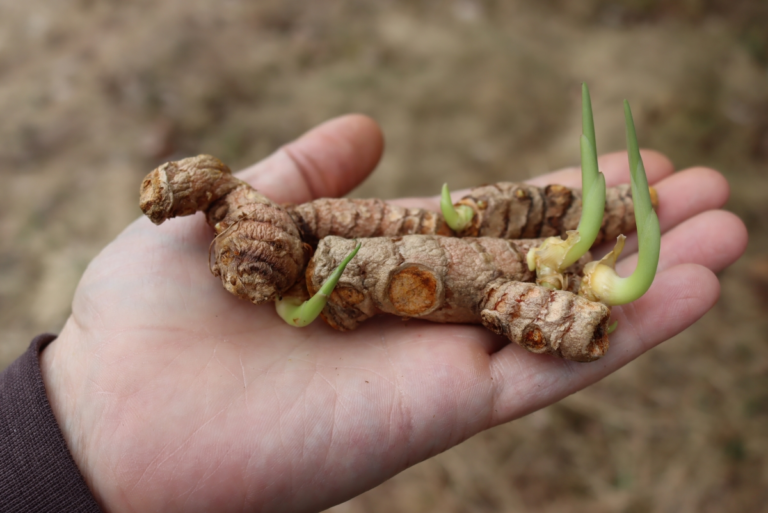The Golden Cane palm is a tropical plant that can reach heights of up to 15 feet tall and thrives in indirect light.

It is important to understand the root system of the Golden Cane palm, as it can affect its health and growth.
The root system of the Golden Cane palm is characterized by thin, fibrous mats that form close to the surface and grow outward from the trunk.
These roots are sensitive to excess water and fertilizer buildup, so regular soil testing and proper watering are essential for healthy growth.
Additionally, this plant requires indirect sunlight, moist soil, moderately high humidity levels, and acidic soil conditions.
While it is resistant to most root rots or diseases, brown spots or dark spots on leaves may indicate an issue with too much direct sunlight or dry conditions.
With proper care and management of these requirements, you can ensure your golden cane palm stays healthy and beautiful!
How to Maintain The Roots of Golden Cane Palm
Proper root maintenance is necessary for the health and longevity of a golden cane palm.

Properly caring for the root system can prevent issues like root rot or nutrient deficiencies.
To keep your golden cane palm healthy, it’s important to provide it with indirect light, moist soil, moderate humidity levels, and acidic soil conditions.
Water regularly, but be sure to avoid overwatering as this can cause root rot.
Fertilize monthly during the growing season with a liquid fertilizer designed for tropical plants.
Lastly, make sure to place your golden cane palm in an appropriate pot away from paths, pools, and houses to prevent its roots from spreading throughout your yard.
Caring for Golden Cane Palm
Caring for a golden cane palm is relatively simple.
This tropical plant can withstand both direct and indirect sunlight, although it prefers bright light without full sun.
To keep the soil moist, water regularly when the top inch of the soil has dried out. Humidity levels should stay between 50-70%, so misting the leaves occasionally will help keep them happy.
Pruning off any dead or damaged stems and leaf tips can also help maintain a neat appearance.
Lastly, make sure to choose an appropriate container with drainage holes to avoid root rot caused by excess water accumulation.
Fertilization of Golden Cane Palm
Fertilizing a golden cane palm is an important part of keeping it healthy and happy. T
his tropical plant requires regular feeding with a slow-release organic fertilizer to promote healthy growth.
The best time to fertilize is during spring when the plant begins to grow again after the dormant winter season.
When choosing a fertilizer, look for one containing seaweed extract, calcium, magnesium, nitrogen, and other essential nutrients.
Balance the amount according to your plant’s needs, and mix it with fish emulsion or seaweed if desired.
Be sure not to over-fertilize or allow fertilizer buildup around the crown of the palm as this can cause leaf burn or yellowing.
The Risks of Excessive Watering for the Golden Cane Palm
Overwatering your golden cane palm is a common mistake that can have serious consequences.
Too much water can lead to root rot, which can weaken the roots and leaves of your palm.
If left unchecked, the plant will eventually die.
Symptoms of overwatering include yellow or brown spots on leaves, wilting foliage, and dark spots at the base of the plant where roots are rotting away.
To prevent this from happening, make sure to water your golden cane palm only when the top inch of soil is dry.
Additionally, be sure to check for drainage holes in the pot and use a pot with adequate drainage for healthy growth.
Finally, avoid excessive amounts of liquid fertilizer as this can also contribute to root rot.
Golden Cane Palm diseases.
The Golden Cane Palm is a beautiful tropical plant often used as an indoor or outdoor ornamental.
While this plant is generally hardy and low-maintenance, it can still be susceptible to certain diseases if not properly cared for.
One common disease of the Golden Cane Palm is root rot, which can occur due to overwatering or excess fertilizer buildup.
Symptoms of root rot include yellow or brown spots on leaves, wilting foliage, and dark spots at the base of the plant where roots are rotting away.
To avoid this problem, make sure you water your Golden Cane Palm only when the top inch of soil is dry, and check for drainage holes in the pot before planting.
Additionally, provide your palm with indirect light and keep humidity levels high by misting regularly.
Nutrient deficiency
Nutrient deficiency is a common problem that can affect the health of your Golden Cane Palm.
When it occurs, the plant will begin to lose its vibrant green color and develop yellow and brown spots on the leaves.
To fix this issue, you’ll need to add more nutrients to the soil to balance potassium and magnesium levels.
This can be done by using a slow-release fertilizer with magnesium at least once every few months.
Make sure not to overdo it though as too much fertilizer can lead to further problems such as root rots.
Additionally, make sure that your palm is getting enough indirect light and that the soil is kept moist but not overly saturated with water to promote healthy growth.
Conclusion
In conclusion, the Golden Cane Palm is a great addition to any indoor or outdoor space because it adds an exotic touch that’s sure to spruce up any environment.
These palms are resilient and can withstand a variety of environments and light conditions, although they do best when given indirect sunlight and kept in moist but not overly wet soil.
To ensure your palm remains vibrant, be sure to provide adequate fertilizer with magnesium every few months.
Additionally, keep an eye out for nutrient deficiencies, yellowing leaves, brown spots on the leaves, and dark spots on the stems as these are signs of poor health and require immediate attention.
With proper care and attention, your Golden Cane Palm will thrive for many years!






